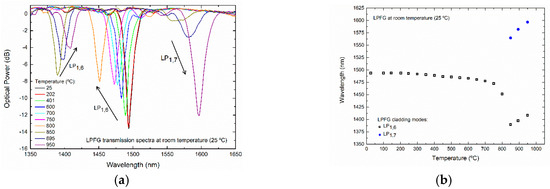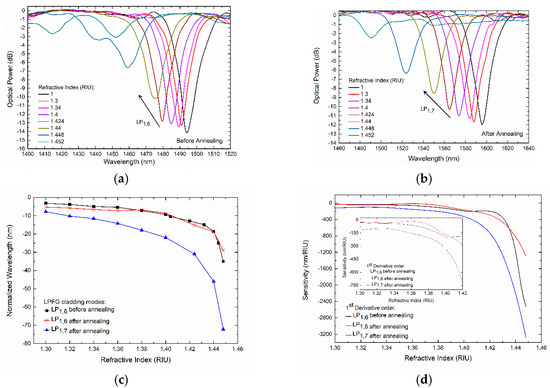Abstract
A femtosecond laser direct writing system was developed to explore the fabrication of long-period fiber gratings (LPFGs) in SMF28 fibers. The LPFGs, showing the mode LP1,6 at 1500 nm, were exposed to high-temperature annealing up to 950 °C. Modifications in the refractive index (RI) modulation are observed through a blue-shift in the LPFG attenuation bands and above 850 °C, the mode LP1,7 appear at 1600 nm. The wavelength sensitivity to external RI from 1.300 to 1.452 was estimated for both modes before and after annealing. Greater sensitivity was found for the higher order mode in the entire range reaching 2400 nm/RIU around 1.440.
1. Introduction
Long-period fiber gratings (LPFGs) are applied in order to couple light between the core and co-propagating cladding modes in standard single-mode optical fibers (SMF28, Corning) [1]. This property turns the LPFGs intrinsically sensitive to external perturbations, such as mechanical stress, temperature, or refractive index (RI) changes in the surrounding medium. Changes in the grating period, in the RI modulation affects the coupling conditions leading to spectral variations and hence sensitivity to parameter to be measured [2]. LPFGs have been used in many sensing applications, such as strain, bending and temperature, for the detection of organic aromatic compounds and as an immobilized antibody biosensor [3].
Concerning the fabrication of LPFGs, several methods have been developed, including the use of UV and CO2 laser radiation exposure, electric arc discharges, mechanical pressure, ion beam irradiation, chemical etching, and IR femtosecond laser radiation [1]. The fabrication of LPFGs has shown to be possible in a variety of optical fibers [4].
In this work, a femtosecond laser direct writing system was developed to explore the fabrication of LPFGs in SMF28 fibers. The phase-matching condition, which results in coupling of wavelengths between the fundamental core mode and forward propagating cladding modes is given by , where is the effective refractive index of the propagating core mode at wavelength , is the effective refractive index of the cladding mode, and is the period of the LPFG [1]. The coupling resonant wavelength can easily be controlled by simply tuning the grating period with its period being defined by the laser beam’s modulation frequency and fiber translation velocity along its axis. The fabrication of gratings with this method has shown to be possible through the fiber polymer coating [5]. The temperature sensitivity of the attenuation band was affected by the change in effective indices due to the temperature dependence of the material RI and the change in the periodicity of LPFG due to thermal expansion of fiber [6]. The femtosecond laser inscribed LPFG can be reliably used for various applications but temperature annealing is necessary, after which the LPFG reaches the regime of spectral stability. Experimental characterization of the spectral response of the femtosecond LPFGs, to variations of the surrounding refractive index (SRI) before and after temperature annealing was carried out.
2. Material and Methods
The writing system for the LPFGs fabrication uses a femtosecond fiber amplified laser (Satsuma HP, from Amplitude Systèmes) providing pulses with duration ~250 fs, and a repetition rate ranging from single shot up to 2 MHz. The maximum average power is 10.5 W in the fundamental wavelength (1030.3 nm), corresponding to 23 µJ per pulse. In the laser direct writing system presented in Figure 1a, three different wavelengths can be chosen: 1030 nm (fundamental wavelength), 515 nm (second harmonic generation) and 343 nm (third harmonic generation). The second harmonic was chosen with a maximum energy per pulse of 1.1 μJ and a maximum average power of 5.5 W, at a repetition rate of 500 kHz. Figure 1b presents the transmission spectra of femto-inscribed LPFG with a period of 388 μm and a length of 60 mm.

Figure 1.
Femtosecond Laser System for LPFGs Fabrication: (a) Schematic diagram; (b) Transmission spectra of femto-inscribed LPFG (inset: Grating structure inside of fiber optic core).
The optimum conditions to write LPFGs in SMF28 were attained with 65 mW on-target power, and 50 μm/s scan speed. The fiber was placed on the XYZ stage and a 40× aspherical lens (Newport 5722-A-H) with a numerical aperture of 0.55, was moved to locate the focus inside the core of optical fiber. For writing waveguide gratings, the laser gate was externally controlled by a periodic square time function with a duty cycle of 50% generated by the synthesized function generator (DS345, Stanford Research Systems). This simple arrangement allows the automated writing of gratings by simply translating the optical fiber at constant velocity with the signal modulation turned on.
After the fabrication each LPFG, with a period of 372.5 μm and a length of 30 mm, was placed in a tubular oven (Termolab, Portugal) and annealed at constant temperature (from 25 °C to 950 °C in steps of 50 °C), for a period of 5 min in each step. The grating spectra were recorded after the annealing step, and after the grating cooled down to room temperature.
3. Results and Discussion
The annealing process leads to modifications in the LPFG spectral response affecting its sensitivity to the SRI. The results of the spectral variations with the annealing temperature are presented as well as the characterization to the SRI (before and after the annealing).
3.1. Spectral Tunning of LPFG through Thermal Annealing
Figure 2 presents the LPFG measured transmission spectra (a) and wavelength shift (b) at room temperature (25 °C) after annealing at each temperature.

Figure 2.
(a) Transmission spectra of the LPFG at room temperature (25 °C) after annealing at the specified temperature; (b) wavelength shift.
The sensitivity to temperature of the LPFG is around 91 pm/°C for this type of fibers and a red shift is observed [2].The thermal annealing of femtosecond LPFGs allows the stabilization of the core modulation, with a small blue shift at room temperature after new temperature increase being observed. From Figure 2 this behavior is similar up to 750 °C with a shift of 21.2 nm where it starts to increase up to 850 °C with a larger blue shift of 83.2 nm. At this point the higher order mode LP1,7 appear at 1560 nm. For temperatures above 850 °C, a red shift is observed for both modes: 11.16 nm for the mode LP1,6 and 14.64 nm for the LP1,7.
3.2. LPFG Refractive Index Characterization
Figure 3a,b present the measured transmission spectra (before and after annealing at 950 °C) corresponding to LP1,6 and LP1,7 modes, for several SRI values between 1.000 and 1.452 (Cargille AA).

Figure 3.
LPFG: (a) measured transmission spectra for the cladding mode LP1,6 before annealing; (b) measured transmission spectra for the cladding mode LP1,7 after annealing; (c) normalized wavelength variation with the surrounding refractive index; (d) wavelength sensitivity as a function of the surrounding refractive index.
The normalized wavelength shifts to the initial state (RI = 1.000) as a function of the SRI, from 1.300 to 1.452, is shown in Figure 3c for the LP1,6 mode before and after annealing and LP1,7 after annealing. Figure 3d presents the first derivative of the data plotted in Figure 3c. A wavelength sensitivity of 2400 nm/RIU was achieved for a SRI of 1.440 for the LP1,7 mode, while for the mode LP1,6 the reached sensitivity was around 1400 nm/RIU. The inset in Figure 3d displays the close up view of the sensitivity to the SRI in the 1.300 to 1.420 regime, showing a clear increase of the sensitivity of the higher order mode LP1,7 while the mode LP1,6 kept its average behavior before and after annealing. Based on the step changes and associated measurement fluctuations, resolutions of 0.0039 RIU, 0.0039 RIU and 0.0025 RIU were achieved for the cladding mode LP1,6 (before and after annealing) and LP1,7, respectively.
4. Conclusions
After annealing the LPFG at high temperature, a higher cladding mode appears, which means that we can fine tune the grating position with thermal treatment instead of varying the period of the refractive index modulation. The LPFG inscribed by femtosecond laser radiation after annealing treatment shows RI sensitivity up to 3200 nm/RIU, for the cladding mode LP1,7. Extensive work needs to be done in order to understand the effects of the annealing the femtosecond inscribed LPFG at higher temperatures.
Funding
The research leading to these results was developed in the framework of Project SAFE WATER—“On Chip Whispering Gallery Mode Optical Microcavities For Emerging Microcontaminant Determination In Waters” which is supported and co-funded by the European Commission, Directorate-General Communications Networks, Content and Technology (DG CONNECT) under the ERA-NET Cofund scheme—Horizon 2020 “Horizon 2020–the Framework Programme for Research and Innovation (2014–2020)” Grant Agreement No 688735.
Acknowledgments
This activity is supported by grant, SFRH/BD/110035/2015, from the Ministry of Education and Science of the Portuguese Government.
Conflicts of Interest
The authors declare no conflict of interest.
References
- Thyagarajan, K. Optical Fiber Gratings. Guid. Wave Opt. Compon. Devices 2006, 1, 233–242. [Google Scholar]
- Li, B.; Jiang, L.; Wang, S.; Tsai, H.L.; Xiao, H. Femtosecond laser fabrication of long period fiber gratings and applications in refractive index sensing. Opt. Laser Technol. 2011, 43, 1420–1423. [Google Scholar] [CrossRef]
- Coelho, L.; Viegas, D.; Santos, J.L.; Almeida, J.M.M.M.D. Enhanced refractive index sensing characteristics of optical fibre long period grating coated with titanium dioxide thin films. Sens. Actuators B Chem. 2014, 202, 929–934. [Google Scholar] [CrossRef]
- Ahmed, F.; Ahsan, M.S.; Lee, M.S.; Jun, M.B.G. Femtosecond laser based in-fiber long period grating fabrication for improved solution sensing. In Proceedings of the Laser Applications in Microelectronic and Optoelectronic Manufacturing (LAMOM) XVIII, San Francisco, CA, USA, 13 March 2013. [Google Scholar]
- Allsop, T.; Dubov, M.; Dobb, H.; Main, A.; Martinez, A.; Kalli, K.; Webb, D.J.; Bennion, I. A comparison of the spectral properties of high temperature annealed long-period gratings inscribed by fs laser, UV, and fusion-arc. In Proceedings of the Reliability of Optical Fiber Components, Devices, Systems, and Networks III, Strasbourg, France, 24 May 2006. [Google Scholar]
- Allsop, T.; Kalli, K.; Zhou, K.; Smith, G.; Komodromos, M.; Sugden, K.; Dubov, M.; Webb, D.J.; Bennion, I. Comparison between femtosecond laser and fusion-arc inscribed long period gratings in photonic crystal fibre. In Proceedings of the Photonic Crystal Fibers III, Prague, Czech Republic, 6 May 2009. [Google Scholar]
Disclaimer/Publisher’s Note: The statements, opinions and data contained in all publications are solely those of the individual author(s) and contributor(s) and not of MDPI and/or the editor(s). MDPI and/or the editor(s) disclaim responsibility for any injury to people or property resulting from any ideas, methods, instructions or products referred to in the content. |
© 2019 by the authors. Licensee MDPI, Basel, Switzerland. This article is an open access article distributed under the terms and conditions of the Creative Commons Attribution (CC BY) license (https://creativecommons.org/licenses/by/4.0/).